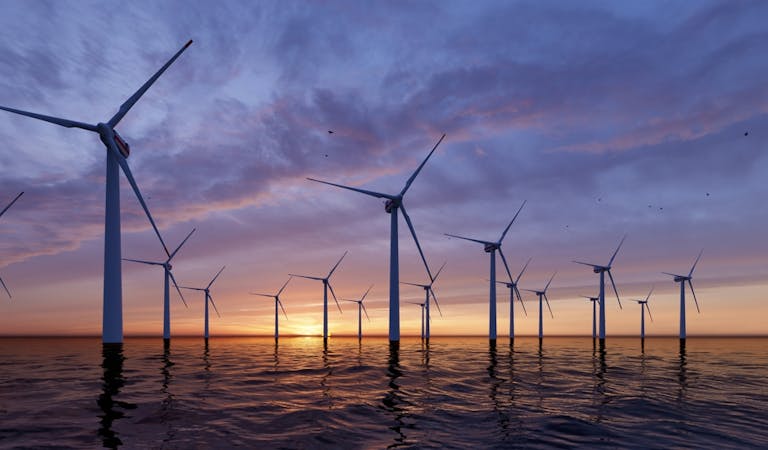It’s all about ‘Location, Location, Location’ for offshore patents

Right now, offshore is the place to be for renewable energy, and particularly for wind power. The sector is undergoing huge growth, and everyone wants to be a part of it. If you are a start-up or small business working in offshore technologies, protecting your innovations is crucial so you don’t lose out as the sector takes off.
Patents are a great way to do that, but are they really worth it if they might not even extend to offshore locations? And how can you strategically protect yourself without breaking the bank? At Onsagers, as patent attorneys and IP strategists, we regularly advise on questions like these, so here are a few things worth considering.
My inventions are used in the sea and patents only apply on dry land, don’t they?
Patents are territorial, but this doesn’t restrict them to dry land (at least not in countries having a coastline!) Once offshore, how far patent rights stretch from land depends on the territory and the technology. For example, in the UK, patent rights are extended further offshore than territorial waters for activities relating to searching for fossil fuels and other natural resources. This extension doesn’t apply to wind power, however, as was recently ruled in a court case between Siemens and GE over GE’s Haliade-X wind turbines, which are to be deployed at Dogger Bank. In contrast, in the US, in ruling on the Haliade-X wind turbines, a judge decided that patent law extends to the full breadth of the Outer Continental Shelf, which extends much further out than the 12-mile territorial waters limit of the US.
Even if your product is to be used further into the sea than patent laws extend, patents can still be very useful. A patent can generally be used to protect against actions such as making, keeping, or importing a product, or using a process. Patents also protect products obtained from processes. There are plenty of ways to protect your innovation onshore (and in territorial waters) by restricting activities that are carried out before the product is taken into the middle of the sea.
Some offshore products are only constructed or completed in their final location. In these circumstances, patents still have their uses! Wind farms or turbines may be erected in the middle of the sea, but their component parts still have to be made and transported over land and through territorial waters. Some patent laws protect against supplying essential elements of a product or process, so having the main components of a wind farm or turbine in territorial waters or supplying those main components to someone for use in their wind farm or turbine may be an infringement of a patent protecting the wind farm or turbine. If you are able, protecting smaller component parts or even individual components can also be very useful, this is where a patent attorney can really help.
When patent applications are prepared, it is important to discuss points around where the final product is constructed, where products are manufactured, how and where they are transported and stored, or where processes are used with your patent attorney, so that we can devise the best set of claims for your inventions. It is important that your patent rights will include all potentially useful claim categories (apparatus, method, “kit of parts”, software and so on) with a scope of protection that can be utilised to restrict third parties in terms of both onshore and offshore activities.
There are almost 200 countries in the world, so how on Earth do I choose where to pursue patent protection?
Choosing territories in which to file for patent protection can seem like a daunting task, but the tips below will make your decision-making and discussions with your patent attorney much more streamlined. It is worth noting that, for most countries, you will have plenty of time to make these decisions, up to 30 or 31 months after filing your first patent application depending on the route you take, although you only get to make that decision once and it is important to plan ahead, especially considering the potentially large costs. A 30 or 31 month delay for this decision can be gained by initially filing a ‘priority’ patent application in one country for the first 12 months and then making use of the patent cooperation treaty (PCT) international filing system, to get a delay of a further 18 or 19 more months, depending on which countries you then choose.
We can guide you with medium/long term planning by setting out suitable timelines and costs forecasts for the key decision points, which should also be incorporated into the IP strategy sections of your business plan.
So, where to start? Generally, your reasons behind wanting patent protection should drive your decisions of where you file patent applications.
One of the main reasons for wanting patent protection is to give yourself an advantage in the market. This could be by stopping others from essentially copying what you are doing, or by preventing similar, competing products or processes from entering the market. Therefore, at the very least, your must-have patent protection should be where you are going to be marketing the product. You may currently only be targeting one or two countries, but you may also wish to consider where your key markets may be in 5, 10, or 15 years, because patents can have a 20-year lifespan.
With offshore inventions, you may be targeting a particular region of the sea, such as the North Sea. As noted above, a region of the sea may include non-territorial waters, and there may be several different countries from which the region is accessible. In these cases, an additional layer of protection can be gained by having patent protection in countries from which that region of the sea is accessible, so that you cut off any route that an infringing product could take to its final location.
See also: The UK and Norway share many connections that will lead to a greener future
Next, depending on budget allowances, you can consider where your main competitors are based, and where they manufacture and/or store their products or use their processes. If they target different markets, you could extend your protection to these markets too. These countries are likely less important than your key markets, but can still be useful to your business. This is because they give you a potential bargaining chip, for use in cross-licensing agreements, for example, or even as another revenue stream if you license use of your invention to others in markets that you are not currently targeting.
If you don’t know where your competitors are based, you could consider key manufacturing countries. China and India are common manufacturing countries in Asia, and in Europe a lot of manufacturing occurs in Germany. For wind power in particular, it may be useful to consider the Netherlands, while more general offshore manufacturing capability and know-how is present in Norway, given its historic links to shipping and existing offshore industries. For some smaller products, you may also wish to consider intermediate countries where the products may be warehoused before being exported around the world. For example, products are often shipped from Hong Kong after being manufactured in China, and so patent protection in Hong Kong can be useful in preventing those products from being dispersed.
There are other reasons for pursuing patent protection than advantages over competitors. For example, you may want to document your products and processes for showing to potential investors, or to improve future freedom to operate, or you may wish to take advantage of offered tax breaks on patented products, such as by using the Patent Box scheme in the UK. Gaining patent protection in your home country can be useful for these, as well as others that are dependent on the circumstances.
Overall, these decisions have to be weighed against the cost of obtaining patent protection and against business needs. There is no use having patents in many different countries if the business has been bankrupted paying all those examination and renewal fees and/or if the business makes no use of those patents. Using the points above can help to direct costs and decisions in a targeted way.
Pursuing patent protection in different countries will come with different associated costs. Applying for patent applications where translations to a language other than English are required, such as in Japan or China, may be more costly than countries where translations are not required, such as Australia or India.
So where exactly is best for offshore right now?
According to the Global Offshore Wind Report from WFO, the top 10 countries for offshore wind capacity in June 2023 are, in order: China, the UK, Germany, Netherlands, Denmark, Belgium, Taiwan, Vietnam, France, and Japan.
If we look at which countries are currently constructing offshore wind farms with the greatest capacity from the same report, nine countries are listed which are, in order: China, Taiwan, UK, France, USA, Netherlands, Germany, Denmark, and Japan. The size of the Chinese and Taiwanese construction is almost the same, at over 2400 MW, while the UK is installing 1650 MW and France and the US around 1000 MW.
If we change the parameters slightly to look at floating offshore wind, these considerations are different again. Floating offshore wind farms are only operational in the UK, Norway, and Portugal. The UK and Norway are undoubtedly at the forefront of floating offshore wind, with more projects being planned (both Norway and the UK have some of the longest coastlines in the worlds; in fact, Norway’s coastline is the second longest after Canada’s according to some measures).
UK’s Catapult for Offshore Renewable Energy puts the UK and Norway among the top ten ‘near-term markets’ for floating offshore wind along with Japan, France, South Korea, Taiwan, the USA, China, Portugal, and Ireland [2]. Many other countries are considered likely to engage with floating offshore wind in the near- and long-terms – it seems the whole world sees wind power as the future!
Based on this data, it seems a good patent filing strategy would include at least China, the USA, and Europe, and maybe Japan, South Korea, and Taiwan. Taiwan is not typically part of many patent portfolios because a Taiwanese patent has to be applied for at the 12-month point and cannot be obtained via the PCT route, which is the route many applicants take. If you see Taiwan as a key or emerging market for you, let your patent attorney know as soon as you can because it is easy to miss the deadline! Taking a longer-term view, Australia, Canada, Brazil, and India may also be useful to consider.
Usefully, you can apply for patent protection in Europe using a single process via the European Patent Office. In this case, given how many of the countries above are in Europe, this can make sense for offshore applications, and especially if you are looking to use your products in the North Sea. Once the patent is granted, you can then choose which territories to cover. France, the Netherlands, Germany, and Denmark can now be covered by a single patent known as a Unitary Patent. The Unitary Patent gives you protection in many countries across Europe at a reduced rate. The UK and Norway are not part of the Unitary Patent, but you can still get patent protection through the European Patent system.
It may also be worthwhile comparing costs for the European Patent Office with costs for a set of national applications if you might focus on a smaller list of key states, e.g. for floating offshore wind then you may decide that only UK and Norway are needed in a core group of jurisdictions. In that case it can be considerably cheaper (and often quicker) to proceed with national applications in UK and Norway rather than using the European Patent Office. Indeed, this is a strategy already adopted by others in the energy sector, e.g. for patent rights linked to offshore oil and gas.
Looking at current statistics on patent filings for offshore wind energy (from the recent patent insight report on offshore wind energy published by the European Patent Office), our strategy of ultimately filing in Europe, the USA, and China seems to be a common one. For patent filings relating to offshore wind energy in 2021, the latest year for which data is available and considered complete, the European patent office received the most filings of any individual territory at 398 (we are excluding the PCT system here to concentrate on specific territories).
The Chinese patent office received 282 applications, and the US patent office received 267. South Korea, Australia, and Canada received next most. Neither Taiwan nor Japan are in the top 10 countries for filings, although this may be due to the difficulty of filing in Taiwan and the additional language requirements in Japan and Taiwan. Regardless, if you see these are crucial markets for your product, then it makes sense to include them as part of your filing strategy.
Patent strategy is hugely important for offshore innovation, with the location of your patents and applications being crucial in determining whether you end up as one of the bigger fish or just a minnow. Onsagers are experts in patents and in IP strategy more generally, so if you need a new IP strategy or to review your existing IP strategy, why not get in touch?
Contributors
Adam is a Senior Partner of Onsagers and a highly experienced European Patent Attorney with an academic background in engineering.

